#Orkney Isles
Text
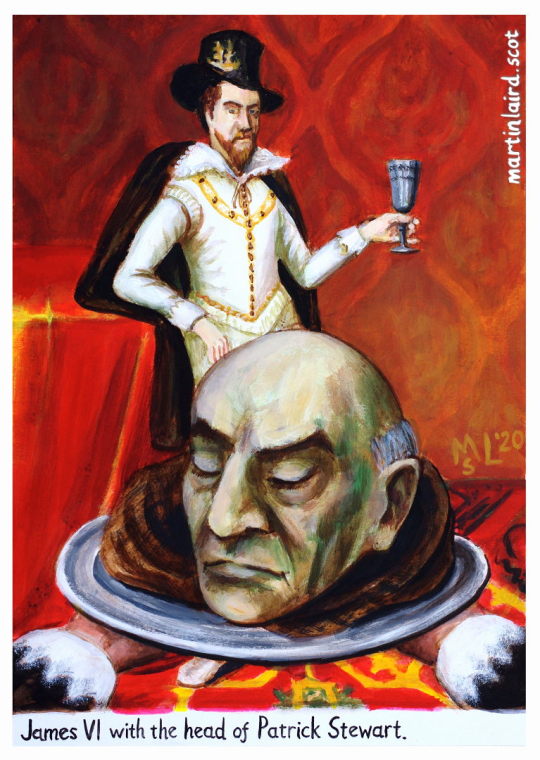
On February 6th 1615, Patrick Stewart, the tyrannical 2nd Earl of Orkney was beheaded in Edinburgh for treason.
As promised, a follow on from Sunday's post about Robert Stewart, an equally unpleasant member of the Stewar family that influenced Scotland so much.
Ultimately a footnote in the sweep of Scottish history, the earl was — and remains — locally infamous for his decadence and cruelty. He persecuted “witches” gleefully, one name : Alison Balfour, he accused of attempting to murder him. Stewart said that absent vigorous prosecution his subjects “wald all have becommit witches and warlockis for the people ar naturally inclynit thairto,” though the property forfeiture accompanying a witchcraft conviction might also have had something to do with it.
None of this had aught to do with the noble’s fall, although it was cited against him in passing; a treason charge for usurping royal authority arising from parochial jockeying for power did him in.
For those paying attention this basically follows up Friday’s post and sees the karma playing a part.
In 1593, the “iron grip” of the Stewart earls passed from Earl Robert to his second son, 28-year-old Patrick Stewart.
Like his father before him, Patrick’s rule over Orkney was not a particularly pleasant one, earning him the nickname “Black Patie”.
Patrick’s reputation for extravagance, arrogance and greed was matched only by his love of finery - exemplified in the magnificent Earl’s Palace in Kirkwall.
Stewart held the native Orcadians in very low regard. When not bickering with his own family, his time was spent feuding with the more powerful local families.
By 1606, Earl Patrick was heavily in debt and ignored a summons to appear before the Privy Council, in Edinburgh, to explain the complaints received regarding his extremely oppressive rule. He was even charged with treason but the charge was dropped in 1607, such was the power of The Stewarts.
The appointment of Bishop James Law, in the same year, marked the beginning of Patrick’s end. The bishop, a close friend and confidante of the Scottish king, James VI, presented a petition before the king, describing the oppression suffered by the people of Orkney. It is thought he also made mention of the danger the Stewart family posed - at this time the islands were still more Norse than Scottish. The latter statement probably prompted the King to take action.
In 1610, at the age of 35, Earl Patrick Stewart was indicted on seven charges of treason, on the ground of usurping royal authority. He remained in Edinburgh Castle, despite pleading justification for his actions on the islands’ County Laws.
While incarcerated, Patrick appointed his illegitimate son, Robert, as his deputy in Orkney. Robert had instructions to regain his father’s “houses” and to collect rents to prepare for his hoped-for restoration to the Earldom.
Robert’s attempt to comply with his fathers orders resulted in what amount to a rebellion against royal authority. Earl George Sinclair of Caithness - who had a score to settle with the Stewarts - came to the King’s aid, volunteering to lead and pay for an expedition to Orkney to quash Robert Stewart’s rebellion.
After a long siege of the Kirkwall Castle, the Bishop’s Palace and St Magnus Cathedral - where supporters were garrisoned - the Stewart rebellion was brought to its knees by the work of a traitor working from the inside.
Earl George threatened to demolish St Magnus’ Cathedral as a reprisal against the Orcadians who had nearly ruined him but fortunately Bishop Law persuaded him otherwise.
Patrick Stewart, the man destined to become Orkney’s most despised earl, was found guilty of treason in 1615, and subsequently beheaded. And according to tradition, so wicked was he that his execution had to be delayed for several days to give him time to learn the Lord’s Prayer.
As I touched upon earlier the accusation of witchcraft had become a particularly convenient way of depriving people of their land - in the following century there were many trials, often beginning in St Magnus Cathedral and ending at the stake.
And so the tyrannical Stewart’s reign ended in the northern isles. The picture shows Coat of arms of Earl Patrick. The first and fourth quarters show the Scottish royal arms debruised by a ribbon, a symbol of bastardy, while the second and third quarters show the arms of the Earldom of Orkney, you might recall from Monday’s post the Stewarts sprang from illegitimate children of King James the V. Other pic is The Earls Palace ruins at Kirkwall.
Such was their prowess at spreading their seed that recent DNA research shows that a remarkable round half of men with the Stuart or Stewart surname - regardless of the spelling - are believed to carry a unique marker in their Y chromosome which identifies them as the direct descendants of a 13th Century nobleman who fought alongside William Wallace and whose subsequent lineage includes the Stuart monarch, James VI of Scotland, so if you are a man and your surname’s Stewart/Stuart, around about half of you have royal lineage.
Pic is by Martin Laird https://martinlaird.scot/drawing-painting/james-vi-earl-patrick-stewart/
8 notes
·
View notes
Text
ohoho we've got a weather warning on for a proper storm lads-- but uh. hee hoo he's uh. he looks like..........
no. I shan't say it.

👁️👁️
#:)#I am going fucking nowhere for the next three days#that's a beastie of a storm#storm babet#love that living in scotland means they have to include the orkneys and shetlands. and it looks like that#i would NOT want to be on the northern isles during a storm tho... there's very little tree cover as it is#basically no trees up there
49 notes
·
View notes
Text

Perfect excuse for a ‘feeding the five thousand’ joke
11 notes
·
View notes
Text
Me: Never talks about my orkney oc, ever, all y'all know about her is that her name is Bodil.
Me: anywho here are tattoos she has.

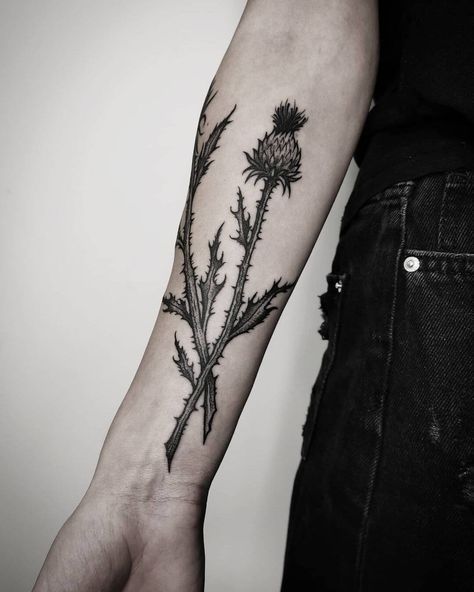

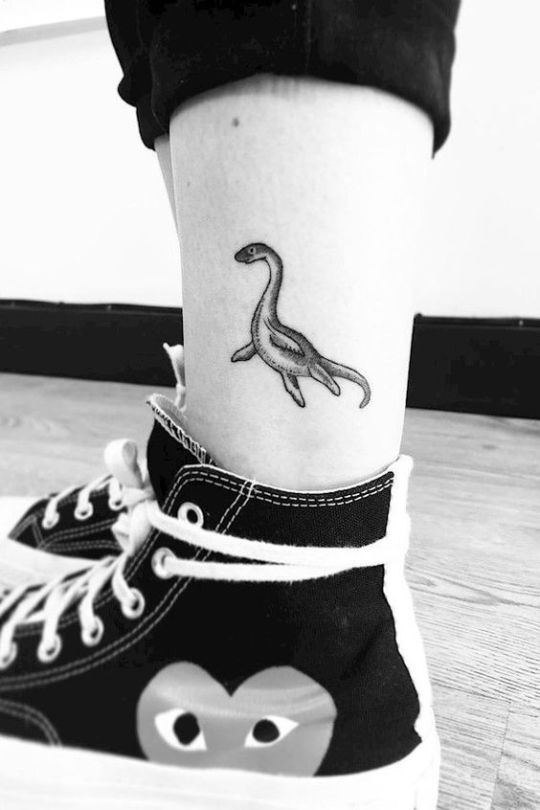
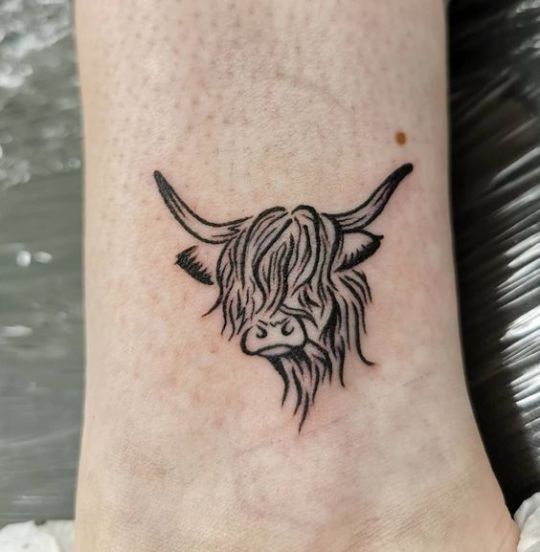
Bodil got the highland cow because Ailsa (Caithness) really wanted one but was scared to get it by herself <3
#aph orkney#hws orkney#I;m gonna ramble about her and shetland tonight#I've been thinking about them all day#hetalia#hetalia oc#hetalia hc#aph british isles#hws British isles#aph nordics#hws nordics#ig
5 notes
·
View notes
Text
sailing
Route:
Flug über Dublin nach Glasgow - mit dem Zug nach Inverness - Beginn des Segeltörns - Orkney Islands - Fair Isle - Shetlands - über die Nordsee nach Norwegen - Alesund - Flug von Vigra nach Oslo.
0 notes
Text

Moody seaside graveyard, Orkney Isle, Scotland
April 2024
#my photography#scotland photography#scotland#orkney#ocean photography#dark and moody#moody aesthetic#walking in nature#nature photography#wild nature
235 notes
·
View notes
Text

Mountain hare, also known as blue hare, tundra hare, variable hare, white hare, snow hare, alpine hare, and Irish hare, is a species of Palearctic hare that is largely adapted to polar and mountainous habitats.
This species is distributed from Fennoscandia to eastern Siberia; in addition, isolated mountain populations occur in the Alps, Scotland, the Baltics, northeastern Poland, and Hokkaidō. In Ireland, the Irish hare (L. t. hibernicus) lives on lowland pastures, coastal grasslands, and salt marshes, not just in the mountains. The mountain hare has also been introduced to Iceland, Shetland, Orkney, the Isle of Man, the Peak District, Svalbard, the Kerguelen Islands, the Crozet Islands, and the Faroe Islands. In the Alps, the mountain hare lives at elevations from 700 to 3,800 m (2,300 to 12,500 ft), depending on geographic region and season.
Instagram.com/karolwildlifephotography/
56 notes
·
View notes
Note
Hi! I really want to read the vulgate cycle but I have a hard time staying focused when reading it. Are there any sections of the vulgate that are not as important to the understanding or able to skip? Thank you so much for making all these stories accessible and thanks for your reply :))
Hello my friend! This is a great question and one I get a lot. The Vulgate Cycle is long and daunting, but I can help you navigate it!
Firstly, here is the full Vulgate Cycle PDF collection for everyone to read. Secondly, I'll summarize what you can do, and elaborate below a cut.
TL;DR
If reading a PDF, use CTRL+F to find your favorite character's name/stories.
If reading a physical copy, utilize the index (located at the very end of the Post Vulgate) to find them.
Discover chapters of interest from the summary page (also located at the very end of the Post Vulgate).
Skip The History of the Holy Grail and begin with The Story of Merlin or Lancelot I.
Now, let's break down the ways you can navigate the Vulgate Cycle step by step.
CTRL+F
This option will certainly be less effective if your favorite character is a prominent one such as Lancelot or Gawain as they appear a million times. However, if you want to learn more about someone else, say, the Lady of the Lake, you can search her up and find every instance of her appearance. Like so.
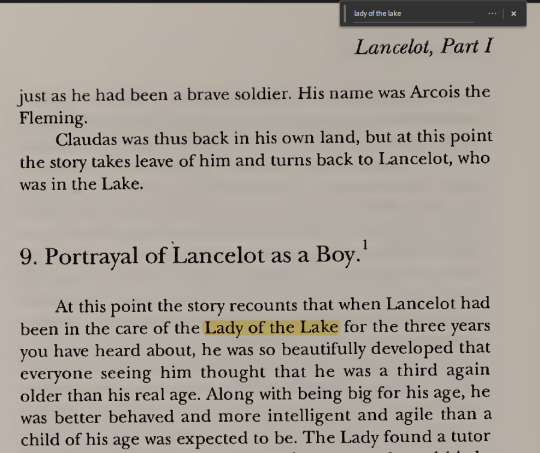
Index
In the very back of the final book of the Post Vulgate, there's an Index listing every named character [Ex: Gawain], location [Ex: Orkney Isles], entity [Ex: Holy Spirit], animal [Ex: Gringalet the horse], and language [Ex: Hebrew] mentioned in the entirety of the Vulgate Cycle. There you'll find a list of which book/chapter/page they appear in. Here are all the mentions of Gawain's horse in The Book of Merlin.

Chapter Summaries
Each book of the Vulgate Cycle has a Table of Contents with the chapter numbers and long, descriptive titles. That alone may give you an indication of what you want to read. However, at the back of the Post Vulgate, right before the Index, there's a list of every chapter in the Vulgate Cycle with a summary of events. That will give you more detail and may help you decide if you want to read in full.
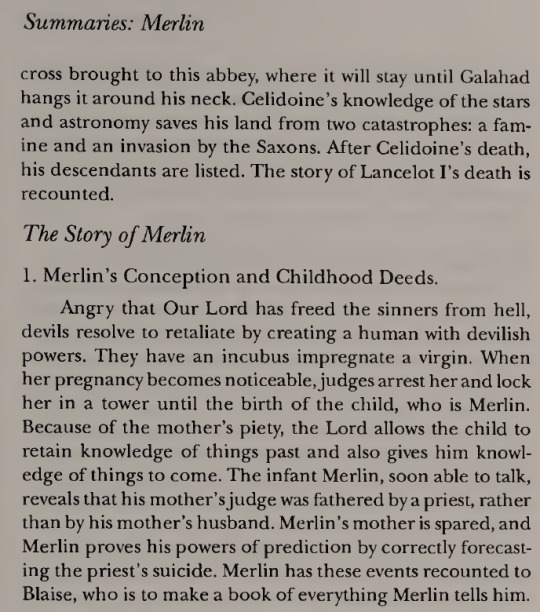
Skip
If it sucks, hit da bricks. The beauty of the Vulgate Cycle is that you don't need The History of the Grail or The Book of Merlin to understand what comes later. I enjoy them because History gives a ton of background to the religious themes the Grail Quest will eventually explore and sets up all the motifs way in advance and Merlin has the Orkney Bros as well as Yvain and Sagramore as kids which is fun. But the fact is you can begin with Lancelot I and you won't be lost. Lancelot I was written first, Merlin is a prequel, so it's optional, and the motifs of the Grail Quest are going to be heavy handed when you get there anyway without the added stuff from History. That's hundreds of pages you can skip if you want to! Norris J. Lacy, the head editor, and his translation team did a phenomenal job with footnotes throughout, so if a character off-handedly refers back to something, you can rely on them to leave a little note at the bottom for you to refresh your memory with. It'll even give you a chapter/page number if you want to refer back yourself. Here's a footnote referring to Agravaine's unnamed amie [his ladylove] who helped wing woman her sister to romance Gawain. That was 4 chapters prior to this moment.
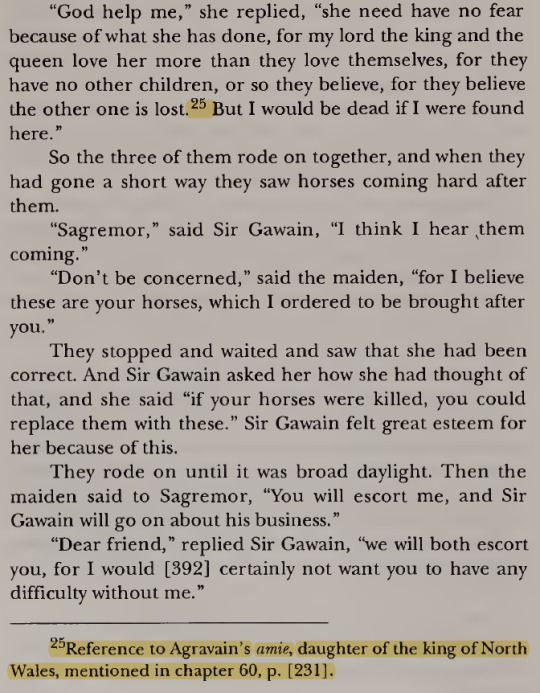
So there are plenty of ways to navigate the Vulgate Cycle and make it more digestible. That being said, it's translated so beautifully by Lacy and his team, that it reads like a modern novel. I have no doubt that once you get started, you'll become invested, and find it much easier to work through than you first thought. It's long-winded and character dense but it's fun. I do hope you're able to read it and understand why I love it so much! Thanks for this ask and I hope this helps. Have a great day!
#arthurian legend#arthurian legends#arthuriana#arthurian mythology#arthurian literature#the vulgate cycle#the vulgate#vulgate#post vulgate#quotes#resource#reading recommendations#my post#ask
111 notes
·
View notes
Note
I’ve never heard of ScotNor before, is there any historical background for the ship? Just curious, they’re a cute couple!
The historical background is a large part of what makes a ship interesting to me, and ScotNor’s history is definitely of great appeal along with their peoples and culture. I’ve touched upon this topic before, but that was probably years ago now, so we’re due for a bit of a refresher! Thanks for the interest 🙏 I’m sure there’s no history I’ve not included in my time line below, but this a summary of what I’ve gathered so far.
Viking Period (→ 1066).
The earliest contact between the nations Norway and Scotland begins in the Viking Age and it presents itself in different manners. Norway is expanding across the islands in the Norwegian Sea and the North Atlantic and gain sovereignty over Shetland, Orkney, and the Hebrides among others. Note that this is almost exclusively Norwegian people – the Danes usually went to England and the Swedes went East. This increased the contact between the two nations, manifesting in settlement, integrating with the locals, and more trade. There were some disagreements and there is still several theories about how violent and early the colonisation of the Scottish islands were, but we find some evidence that their interactions remained mostly peaceful in the certain areas. Norwegian Vikings definitely fought against both Gaels and Picts before they joined forces.
The celtic name Laithlind/Lochlann, is thought to reference Scandinavia – mainly Norway, but might also be the word for the Norwegian areas of Scotland. The word means “land of bog/lakes” and could be related to the Welsh word for Scandinavia; Llychlyn
Norse Period (1066 – 1468).
The Norse Period is the name of a period in Scotland from the end of the Viking Age in the middle of the 11th century to 1468, when the Danish King gives away the last of Norway’s territories on the British Isles to the Scottish King as a dowry. During this period people in the Norwegian occupied areas identifies as Norse and their language evolve from Norse into Norn, which was in some places spoken until the 1800s.
The Battle of Largs was fought between Norway and Scotland in 1263 A battle at both sea and on land with no winner. They fought over the rights to the Western Isles, which the Scottish King had tried to buy since 1240, but had been rejected. The Norwegian King felt threatened and left Norway with a great fleet to negotiate/fight. After failed negotiations and some Norwegian raids a huge storm surprised the fleet and crashed some of the boats and washing them ashore where the crews were attacked by twice as many Scottish forces. The storm hindered any tactical moves as the waves and wind made it impossible to control the ships, but eventually the Norsemen got back on some of the ships and it became a long distance battle, which both sides pulled back from after a while. The Norwegian King died from illness in Orkney later that year and his son negotiated a treaty with the Scottish King where he gave up the islands for money and trading prospects with Scotland.
Margaret Maid of Norway, was the granddaughter of the Scottish King and the daughter of the Norwegian King. Her mother’s marriage to the King of Norway was diplomatic and a move to strengthen the relations between the countries. Her mother dies in childbirth and Margaret Maid of Norway suddenly become heir to the Scottish throne when her grandfather dies, but unfortunately she dies only 7 years old from illness on her way across the sea to claim her throne in 1290.
Originally, Norway was part of the Auld Alliance. With the negotiating skills of a Norwegian diplomat, Norway became part of the Auld Alliance in 1295, a military alliance that lasted until 1560. Norway was a member until 1326. The alliance marked the end to Norwegian expansion in the British Isles and cemented their collaboration. The Auld Alliance said that if one of the parties was attacked by England, the others should help. Norway were to supply Scotland with warships while England and France were at war, but Scotland never paid and Norway never sent any ships as they were still hesitant to make an enemy out of England. It’s seen as a bit of a scam on Norway’s part as they accepted a pre-payment for their help, but the money “disappeared” and Norway would never have been able to provide the amount of ships and warriors they promised.
Then Norway becomes a part of the Kalmar union as a result of the devastating effect the Black Death in 1348 had on the Norwegian Elite, leaving Norway weak and under Danish rule for about 400 years, where the Danish king in 1468 gives away Orkney and Shetland as a pawn for the dowry of his daughter because he did not have the money to pay (this situation was never actually resolved and the isles still could be considered only a pawn).
Norway under Denmark and Scotland under England (1397 – 1814).
Norway entered a union with Denmark and Sweden in 1397 and proceeded to fall further under Denmark’s rule for about 400 years until 1814, while Scotland entered a union of crowns with England in 1603 and then later a personal union in 1707, which still stands. During these periods it is difficult to talk about the interactions of the nations Norway and Scotland as they both fall in the shadow of the more powerful nation running the union, Norwegians often just considered Danes by people from other countries at this time.
The Battle of Kringen in 1612 was a battle between invading Scottish mercenaries hired by the Swedes, and Norwegian farmers. Denmark-Norway was at war with Sweden again and the Swedes had employed help by foreign forces – very common at this time, and Scottish mercenaries were famous. The Scottish forces were to meet up with Swedish forces, and while they traversed the country they robbed and pillaged Norwegian farms. Norwegian farmers organized and staged an ambush on Scots as they passed through steep terrain, trapping them by cutting trees and disrupting them by rolling rocks down the mountainside. They were only armed with spears, axes and scythes, but managed to absolutely devastate the Scottish army. The Norwegian farmers only suffered 6 deaths while the Scots only had 18 out of 300 make it out alive in the end.
The 1800s.
In the 1800s, Norway was become its own country (still in a union with Sweden) and it’s at this time tourism in the country becomes popular in Great Britain, with both Scottish and English Lords travelling to Norway to fish salmon and hunt and experience the nature. In 1886 a Scottish shipping company began to provide Norwegian cruises to look at the fjords along the coast of Norway, maybe one of the first ever boat cruises, which was so popular that they increased the amount of ships the following year. This continued until World War One began.
In 1806 a Norwegian son of a wealthy merchant travelled with one of their trading ships to the Caribbean, but the ship sank by Jamaica. He drifted on the shipwreck for three days before he was rescued by a British ship. The officer who took care of him was son of a wealthy Scottish landowner, and they became enamoured with each other and never left the other’s side after this. They spent the rest of their lives together, travelling between their estates in Norway, their castle in Scotland, and apartments in London, Paris, Rome, and Naples.
Skotthyll is a game that used to be prevalent in my region, and it’s said to be a game invented by Scottish engineers who came to Norway to work on a railroad in the 1860s.
The 1900s.
When Norway became independent from Sweden in 1905, the new king received a letter from the authorities on Shetland stating that “today no ‘foreign’ flag is more familiar or more welcome in our voes and havens than that of Norway, and Shetlanders continue to look upon Norway as their mother-land, and recall with pride and affection the time when their forefathers were under the rule of the Kings of Norway”.
During the First World War, Norway was neutral, but very much involved with the ongoing politics as they wanted to keep trading with both sides, but eventually settled for Great Britain when they decided to commit to buying all the fish Germany normally would have bought. When the Germans began sinking Norwegian ships, it also drove them further onto the side of Great Britain.
During the Second World War Norway was occupied by Germany, and many of those who fled went to Great Britain (as was the case with most of Europe). On Shetland, there was established a Norwegian base of operations where Norwegian sailors and volunteers would carry out missions across the North Sea to Norway. There they would smuggle in weapons and provisions and information to the resistance, as well as helping refugees to escape the country. This was of immense help to Norway during the war. Additionally, a training camp for Norwegians was established in the Scottish highlands, where Norwegians who wanted to fight for their country was stationed and trained for missions by the Allies.

#historical hetalia#hetalia#scotnor#aph norway#aph scotland#hws norway#hws scotland#thanks for the ask! Always love talking about them - thanks for taking an interest 💖 they're the best ship I promise#long post#so glad I had written about this before - this took a lot longer than expected to put together
40 notes
·
View notes
Text

On 20th February 1472 Orkney and Shetland officially became part of Scotland.
Less than four years earlier, in 1468, the Northern Isles were mortgaged to Scotland for 8,000 florins as part of the marriage dowry between the future James III and Princess Margrethe of Denmark.
But you have to go back a wee bit further for some of the history, following the Battle of Largs, in 1263, and the loss of the Western Isles as a result of the Treaty of Perth, in 1266, Orkney and Shetland were the only part of what is now Scotland to remain in Norwegian hands.
Although the islands were still officially under Norse rule, the control Scottish Earls had over Orkney was on the increase.
This culminated in the appointment of Henry Sinclair, Earl of Roslin to the Earldom in 1379, and heralded changes in the ownership of land and the gradual break-up of the Norse systems of tenure.
The Earldom of Orkney was held for the Norwegian (and later Danish) Crown until 1468, at which time the impoverished Christian I, King of Denmark, Norway and Sweden, “motygaged” Orkney to the Scottish Crown as part of a marriage agreement with King James III.
The Scottish king was to marry Christian’s daughter, Margaret, and by this agreement Orkney was held as a pledge, redeemable by the payment of 50,000 Rhenish Florins.
At the end of the first year the payment had not been forthcoming so Shetland was pledged for a further 8,000 Florins.
Two years later, Christian had still not made the payment so the Earldom of Orkney and Lordship of Shetland were annexed to the Scottish Crown.
As the years passed, the Scottish influence over the islands grew and gradually the Norse way of life and language slipped away. By the late 17th century the variant of the Norse language of Orkney - Norn - was spoken only by the inhabitants of one or two remote parishes.
In 1564, Mary Queen of Scots gifted the Royal Estates in Orkney and Shetland to one Robert Stewart - her half-brother and natural son of James V. Thus began the tyranny of the Stewart line - traditionally hailed as Orkney’s darkest years.
Robert Stewart’s acquisition, and subsequent “handling” of the islands, was documented as followed:
“This miscreant, having secured in addition the whole temporal estates of the bishopric by an excambion effected in 1568, and having become Earl of Orkney in 1581, spent the rest of his life - with the exception of a short period during which he was imprisoned, partly as a penalty for improper negotiations with Denmark - in oppressing the islanders for his own personal advantage.”
25 notes
·
View notes
Text


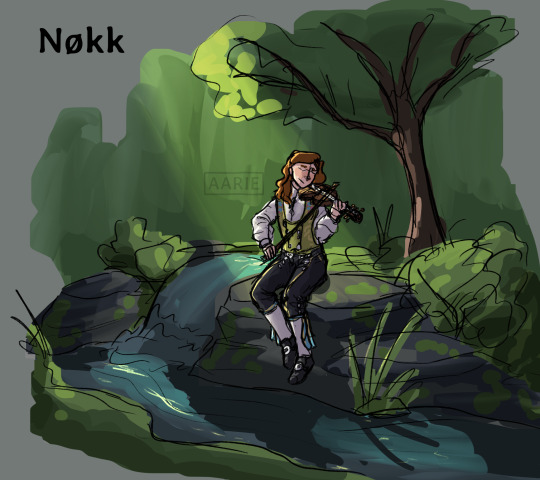

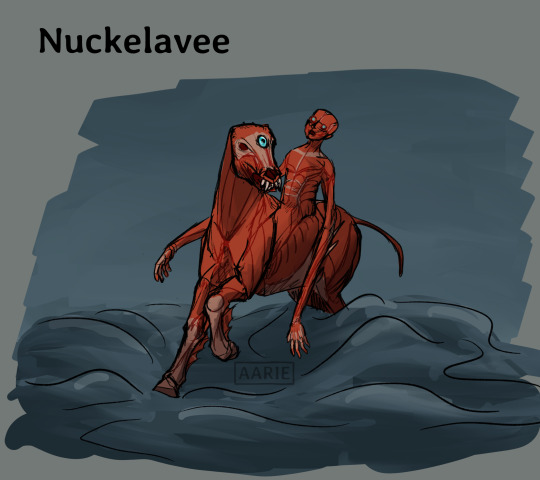
It’s Mermay!!
Because of that, I’ve drawn a collection of water based creatures from the folklore of Northern Europe
I made these quicker than I usually do and I’m very proud of them
Here’s where each one comes from:
Selkie - British Isles, the Faroes, and Iceland
Kelpie - Scotland
Nøkk - Norway (there other versions from different countries with similar names)
Finfolk - Orkney, Scotland
Nuckelavee - also Orkney
#art#aarie’s art#mermay#mermay 2023#most of these aren’t mermaids but I don’t care#selkie#kelpie#nøkk#nøkken#finfolk#nuckelavee#tw gore#tw body horror#the Nuckelavee is so freaky#like it’s gotta be one of the freakiest things out there#I have a finfolk oc but I’m not ready to share her yet#artists on tumblr
255 notes
·
View notes
Photo

Battle of Flamborough Head
The Battle of Flamborough Head (23 September 1779) was one of the most famous naval engagements of the American Revolutionary War (1775-1783). Fought off the coast of Yorkshire, England, it pitted the USS Bonhomme Richard, commanded by John Paul Jones, against a Royal Navy frigate, HMS Serapis. The engagement was an important victory for the burgeoning Continental Navy.
The Expedition Sets Sail
On 14 August 1779, a small fleet of seven vessels set sail from the port of Groix, France, with the intention of wreaking as much havoc as possible in the British Isles. The Kingdom of France had officially entered the American Revolutionary War the year before as an ally of the fledgling United States and had since provided the Americans with military and financial aid. The French had outfitted the ships for the expedition including the flagship, a 42-gun converted merchant vessel called the Duc de Duras, which was gifted to the United States. The makeshift fleet was under the overall command of Captain John Paul Jones, a Scottish-born officer of the Continental Navy, who had recently won international fame for his daring raid on the English port town of Whitehaven in April 1778.
Prior to sailing, Jones renamed the Duc de Duras to the USS Bonhomme Richard; this was in honor of his friend, Benjamin Franklin, whose celebrated Poor Richard's Almanac was translated into French as Les Maximes du Bonhomme Richard. The other ships under his command included the 36-gun frigate USS Alliance, the 32-gun frigate USS Pallas, the 12-gun corvette USS Vengeance, and the cutter Le Cerf, as well as two privateering vessels, the Monsieur and the Granville. Since the ships were setting sail from France, they were mainly crewed by French sailors (except for the Bonhomme Richard itself) and were captained by French naval officers. After raising anchor on 14 August, the fleet sailed toward the southern coast of Ireland.
Trouble beset the expedition almost immediately. On 18 August, they recaptured a Dutch vessel that had previously been taken by a British privateer. The captain of the Monsieur raided the cargo hold of the captured vessel, taking what he pleased before selecting a prize crew to sail it back to Belgium for sale. Jones overrode these orders, however, putting his own prize crew in place and sending it back to France to be sold in his own name. This enraged the captain of the Monsieur, who felt entitled to the prize. That night, the Monsieur abandoned the fleet with the other privateer, Granville, leaving not long after. Jones was hardly surprised by the disloyalty of the privateers but would soon be faced with more discontent from within his ranks. The aristocratic French naval officers under his command despised taking orders from a provincial, Scottish-born American and were not afraid to show their displeasure; Pierre Landais, captain of USS Alliance, was the most outspoken of this group, flatly telling Jones that he intended to sail Alliance as he saw fit.
After the departure of the privateers, Jones' remaining five ships sailed up around the southwest of Ireland before heading north. In late August, Jones sent Le Cerf to reconnoiter the Irish coast, but the cutter soon became lost; after failing to find its way back to the fleet, Le Cerf turned around and sailed back to France. Jones, meanwhile, continued northward with his remaining ships, sailing along the coast of Scotland. Despite the expedition's rocky start, it finally began to prove profitable, as the Franco-Americans took several British merchant vessels as prizes along the Scottish coast. On 3 September, Jones' fleet rounded the Orkney Islands and turned south. He put a landing party ashore at Leith, the seaport of Edinburgh, with instructions to threaten to burn the port unless the residents paid a large ransom. But before the threat could even be made, a strong gale blew Jones' ships away from the bay, forcing him to call off the raid. Nevertheless, the sight of Jones' fleet off the coast of Scotland was enough to cause panic and alarm throughout Great Britain.
Continue reading...
21 notes
·
View notes
Text
ALRIGHT so, Sigurd's first great love was a woman name Fiona, she was technically Scottish. No one really knows what she was like because no one met her and Sigurd's stories of her seem to swing drastically every time he talks about her.
They had two daughters together, Liv and Bodil.
Liv the personification of Shetland is the older of the two, and the eldest of Sigurd's children; she's always been pretty quiet and rather keep to herself. Even around her family and people she knows. Liv always took her title as eldest sister very seriously, having six younger siblings absolutely influenced her personality. On the other hand though; she's very much stands there while one of her younger siblings goes "HEY she asked for no pickles". Sometime in the late 1600s or early 1700s she decided to start going by Fiona after her mother, but kept Liv as a middle name. Her human name as of 2023 according to the government is Fiona Liv Anderson.
Bodil the personification of Orkney is just a few years younger than her sister. Close enough that physically they're the same age. She's just as shut up as her sister around strangers leading a lot of people to believe they're just like each other. In reality Bodil just doesn't trust outside people, once she's around only family/close friends she's a firecracker. A lot of people think she's older then Fiona solely because she gives off a lot more In Charge vibes, I mean, Bodil literally means leader. She's extremely strong, like physically, and has had a few too many talks from Sigurd and Angus alike on why she Can Not Throw Her Siblings Around.
#Faroe is next#maybe Faroe and Caithness#I haven't decided if I'm going to put them in separate posts or together#aph norway#hws norway#aph scotland#hws scotland#aph orkney#hws orkney#aph shetland#hws shetland#hetalia#hetalia oc#aph British isles#hws British isles#aph nordics#hws nordics#human oc#germanic!family
5 notes
·
View notes
Text
Sorry, Johnny Masterlist

Main Characters: Simon "Ghost" Riley, Marianna MacTavish (OC)
Supporting Characters: Johnny MacTavish, Brief Mentions of the rest of the 141 and other random CoD characters.
Synopsis: Johnny's gone and Simon learns that he's not the only one who's grieving his loss so deeply. In their ruthless hunt for Makarov, the hunters become the hunted and the team is driven to ground. Simon should know better but he's got nowhere else to run. Nowhere but a small white wash cottage in the Orkney Isles. Johnny'd just have to forgive him for knocking on her door. He'd have to forgive him for a lot of things.
Warnings: Canon Main Character Death, Descriptions of Canon Typical injuries, Eventual Smut, Grief/Grieving
Ending: Happy - because of course.
Goodbye, Johnny <- Posted
On the Lamb <- Posted
Nowhere Else to Run <- Posted
A Simple Life <- Posted
Bourbon & Photographs <- Posted
Nosy Cows <- Posted
Stay <- Posted
A Sweet Girl & A Desperate Man <- Posted
Dreams & Decisions <- Posted

#my writing#call of duty#cod writing#simon ghost riley#fanfiction#not beta read we die like men#civilian oc#ghost x oc#johnny soap mactavish#oc mactavish#ghost x civilian oc
24 notes
·
View notes
Text
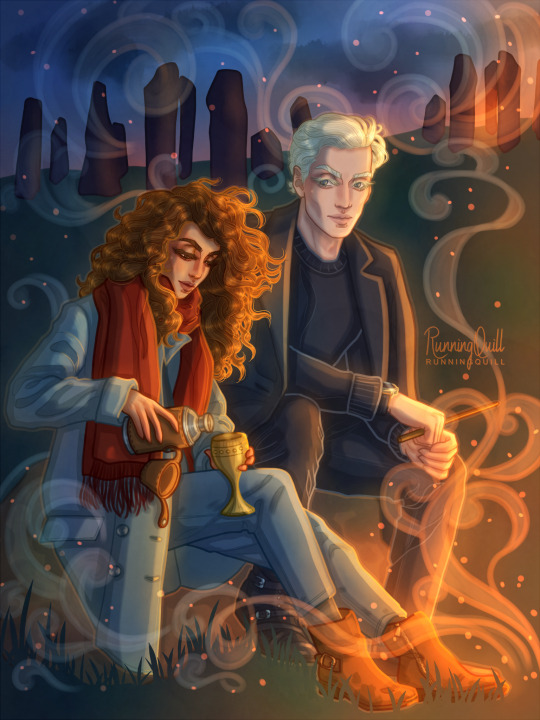
Beltane
“I’ll make us some goblets,” said Granger, plucking protein bar wrappers from Draco’s lap.
“So proper,” said Draco. His mother might actually like Granger.
“This wine has been heated by the flame of Cerridwen. We aren’t sucking it out of a flask like sixteen year olds behind The Hog’s Head.”
Granger Transfigured the wrappers into handsome golden goblets.
Draco would’ve informed her that she was quite the mistress of Transfiguration herself, but he didn’t want her to develop an inflated ego. She nevertheless caught the way he tested the weight of the goblets. She smiled into her scarf.
“Nice sheen on the gold,” he admitted.
“A pretty illusion,” said Granger, looking pleased. “But thank you.” She paused and hesitated before adding, “I heard you’ve an interest in Alchemy, so your approval means more than the average wizard’s.”
“My approval should mean more than the average wizard’s in all things,” said Draco, studying the goblet in the firelight.
Granger raised her eyes to the night sky." - Draco Malfoy and the Mortifying Ordeal of Being in Love, Chapter 10: The Orkney Isles, by @isthisselfcare
#dramione#draco malfoy#hermione granger#draco x hermione#harry potter#illustration#my art#digital art#fanart#digital drawing#dmatmoobil#draco malfoy and the mortifying ordeal of being in love#isthisselfcare#dmhg#dhr#draco malfoy x hermione granger#hp fanart
555 notes
·
View notes
Text
Terrible Fic Idea #90: Hogwarts Legacy, but make it time travel
One of my absolute favorite WIPs at the moment is A Different Legacy by Finexs, in which a female!Harry Potter travels through time and becomes the MC of Hogwarts Legacy. It's an absolutely brilliant fic for a variety of reasons, the most relevant being that it tickled my own brain and brought back a fic idea I had when I first played the game a year ago...
Or: What if the Hogwarts Legacy MC traveled through time to become the competent adult Harry so desperately needs?
Bear with me:
There is absolutely no reason why the governments of the UK and the wizarding UK should be contiguous - or really any reason for there to be a wizarding UK at all. The Treaty of Union came into effect in 1707, whereas the Statue of Secrecy became law in 1692. And since muggle and wizard seemed to have gone their own way long before this... why not take it to the logical conclusion?
For the sake of this AU: Wizarding Ireland has always been its own place, ruled by Irish Wizards, separate from anything going on in Great Britain. Wizarding England is largely made up of a combination of the old Anglo-Saxon states and the Danelaw, while wizarding Cornwall, Wales, Scotland, and Strathclyde all do their own thing. Most import to this fic: the Orkney Islands still belong to the unified wizarding kingdom of Denmark, Norway, and Sweden.
Wizarding Orkney, as part of wizarding Denmark, contains the Orkney and Shetland Islands. The culture reflects their stronger Norse background, and Norn is still the mother tongue - though Scots and English are common second or third languages.
These two archipelagos are ruled by a wizarding earldom, the House of Magnusson, from their seat at Stonybreck Castle on Fair Isle. Prior to her death in 1887, the countess was Eydis Magnusson. When she died the earldom fell to her 12-year-old daughter, Freya - though her muggleborn father, Joseph Evans, does a lot of the heavy lifting at first.
Just imagine it:
Freya Magnusson is a witch who was trained by tutors her entire life. In the spring of 1890 she begins showing signs of a rare magical ability that requires further training, the only teacher of which is a professor at Hogwarts who won't be tempted away for love or money. And so, with great reluctance, Freya begins attending Hogwarts in the fall of 1890 as a Fifth Year.
She proves to be a consummate Ravenclaw with some decidedly Slytherin tendencies whose greatest interests are DADA and Ancient Runes, and if she didn't have an earldom to run the Danish version of Unspeakables would be snapping her up in a heartbeat.
Events of Hogwarts Legacy follow canon. Freya kills Victor Rookwood, defeats Ranrok, and contains the ancient magic.
More importantly for the purposes of this fic, after the skirmish at the Feldcroft catacomb, Freya convinces Anne and Ominis not to turn in Sebastian for killing his uncle... and convinces him to stay with her at Stonybreck Castle during the summer of 1891, to get away from all the reminders and start afresh. This kicks the slow burn they'd been dealing with since almost the moment they met into full gear, and by the end of the summer they're dating.
Sixth and Seventh Year pass without nearly as much excitement. Freya and Sebastian graduate in May 1892. They marry the following year and by late 1894 have a daughter, Ingrid.
Fast forward to the summer of 1898.
By this point, Sebastian has made a name for himself on the professional dueling circuit, winning the European Championships 3 years in a row.
Freya, meanwhile, throws herself into running her earldom, but still finds time to research runes and Ancient Magic. Though she's keen to recreate the mirror-portals she came across in her adventures, Freya takes all the precautions she can... including sending her 3-year-old daughter out of the castle with her father whenever she's testing something particularly dangerous.
...but something still goes wrong, and the magic seems to be pulled out of her, and the castle fills with light...
To the outside world, Stonybreck Castle appears to be caught in a time bubble.
No one can enter, no one can leave, and the goblin nation - more thankful to Freya for stopping Ranrok than any of the human ministries - takes up a watchful vigil over the castle. (Think The Still Ruins in DA:I's Western Approach.)
As the years pass, the mystery of Stonybreck Castle is largely forgotten by everyone except the goblins, who are present when the bubble dissipates in the summer of 1993, revealing a Freya and Sebastian who show no signs that any time has passed for them at all.
They're taken to Gringotts. Once their identities are verified, one of their old goblin friends - now very old indeed - has the unfortunate task of explaining to them just how much time has passed. And just how much the wars took from them.
(Natty died fighting Grindelwald; so did Ominis, though his death was originally thought to be an accident after Grindelwald came looking for his family's Hollow and was only later found to be otherwise. Poppy was maimed fighting poachers and later fell during Voldemort's rise... and so on. Their daughter Ingrid died in 1979, alone, of Dragon Pox, the wars having taken her husband and children long before.)
Their first day in 1993 is spent mourning.
Their second day might well have been spent the same if not for the fact that Harry Potter, freshly escaped from the Dursleys, comes to the bank that morning... and for the first time ever the magical guardians portion of his paperwork is not obfuscated - and reads Countess Freya Magnusson of Orkney and her consort, Sebastian Sallow of Feldcroft.
It eventually comes out that Freya's muggleborn father, Joseph Evans, is the brother of Harry's mother's great-great-grandfather, Samuel Evans, making them first cousins four times removed. Regardless of the details, Freya is Harry's closest magical blood relative, making her and her husband automatically his magical guardians.
This proves to be just the thing Freya needs to pull herself of the depression she might otherwise have fallen into (the guilt over leaving her daughter alone is crushing, and while Ingrid had Freya's father to take care of her... Harry has not been so lucky).
Freya is a one-woman war machine, bulldozing over any and all who stand in her way. Who placed Harry with his aunt and uncle? Why were his parents' ignored? Why did no one check on the boy? Why did no one realize he was being abused? How did the headmaster not realize Voldemort was possessing one of this teachers? Why did it fall to a 12-year-old child to save a classmate from a basilisk stalking the school halls? - She sets out to solve all these problems and more.
Sebastian is equally incensed by all of this, but views a large part of it as Hogwart's failing - after all, if the school had done a better job of teaching why it's such a bad idea to delve into the Dark Arts rather than just saying, Dark Magic bad, they wouldn't be in this position. Some of it is also the Ministry's fault for being so incompetent, but the only way to keep more people from losing themselves to the Dark Arts like he almost did (and more people dying because of those Dark wizards) is education.
And so Sebastian becomes the DADA teacher for the 1993 school year, because even a man 95 years out of time is still preferable to werewolf to the school board. (Or, since Lupin's status as a werewolf is not widely known, a pureblood a century out of time is far preferable to a poor half-blood mated to a man in Azkaban for life.)
Canon does not so much proceed apace as nosedive into AU.
Sebastian is nearly fired within his first month for sitting down with all his classes, explaining what Dark magic really is, why it's dangerous, and why some parts of it can be safely used but why it's very easy to get lost in it. The takeaway is basically: if you want to learn, find yourself a reputable teacher after you graduate, but until then you'll find yourself in detention if I catch you dabbling in it... which is still entirely too pro-Dark for Dumbledore. Although Dumbledore attempts to chide him on it, Sebastian comes back with - among other things - I remember you as a tetchy first year and telling kids why they shouldn't do something works better than a simple no, that's parenting 101.
He goes on to catch Sirius during his Halloween break-in by the simple expedient of having been on his way outside the wards to apparate back to Stonybreck Castle to visit his wife, but by this point they've realized that the MoM has never given him a trial, so rather than tell anyone he takes Sirius home with him, where Freya offers him legal sanctuary on behalf of the Danish government.
Third Year ends up being remarkably peaceful for Harry despite the Dementors, but even they are gone by Easter once the Danish government makes it known they've offered Sirius sanctuary.
Fourth Year has the Triwizard Tournament, but since Sebastian is still DADA professor, he's the one who insists on casting the age lines around the Goblet of Fire and makes it so someone can only put their own name in if they're between 17 and 20. And so Harry is never a part of it - and is too protected by Sebastian and Freya to be easily kidnapped.
Voldemort finally manages to resurrect himself during Halloween 1995 using the blood of Mad-Eye Moody. He slowly gathers forces, staying quiet until he manages a big attack on Platform 9 3/4 on the last day of Harry's Fifth Year. Several students are killed - especially the younger ones - but several more are able to fight back, having had 3 years of DADA under a competent professor.
It quickly becomes undeniable that Voldemort is back - or, as the MoM spins it, someone is pretending to be him to gain power.
Sixth Year is spent with Voldemort on the offensive. Dumbledore tries to counter with the Order, but after 3 years of seeing Freya gradually erode his power base for failing so badly in the aftermath of the war - and 3 years of seeing a DADA teacher teach their children and stand up for them for the first time in living memory - it's to Freya and Sebastian most turn.
Between Freya's Ancient Magic and Sebastian's knowledge of the Dark Arts, they're able to determine Voldemort made Horcruxes without having to wait for Dumbledore to cough up the knowledge. They're able to use runes to track the others down and Ancient Magic to destroy them. When they face Voldie during his attack on Hogwarts in May 1997, he is mortal.
Though they both fight, Sebastian is the one who casts the final blow this time, and he's hailed as the wizarding world's latest savior.
Sebastian goes on to hold the DADA post for 25 more years before going on to replace McGonagall as Hogwarts Headmaster. He holds that post for half-a-century before retiring as one of the most beloved headmasters in Hogwarts history.
Freya continues her research into runes and Ancient Magic, eventually succeeding in making the mirror-portal she so desired. These come to replace long-distance portkeys, with mirror-portal "airports" set up in each of the largest wizarding cities to facilitate travel. She remains a strong political force as Countess of Orkney, but largely stays out of British wizarding affairs after Harry comes of age...
...and Harry, following her example, goes on to use the training they gave him and his own political power as the Boy-Who-Lived to reform the MoM from the inside - starting with the Aurors. It's a long a difficult journey, but by the time he steps down after his third term as Minister of Magic, the MoM utterly unrecognizable. And actually worthy of being called a competent wizarding government.
Bonuses include:
It never being clear what caused the time bubble that catapulted Freya and Sebastian from 1898 to 1993, although Freya comes to suspect it has something to do with having been approximately 4 weeks pregnant at the time. Twins Aleksander and Irene are born 1 February, 1994 - nearly a full century after their sister Ingrid - and both start showing proficiency in Ancient Magic upon reaching their 15th birthdays;
Harry spending nearly his entire Third Year being confused by kind, loving guardians who sweep in and care for him in a way no one ever has before. It's overwhelming and would be oppressive if they didn't also realize that he's a teenager who's been taking care of himself most of his life and therefore try to take his opinions into account. (He also proves to be the best big brother ever to Alek and Irene after they're born);
Harry himself is never a Horcrux, as Horcruxes cannot be made accidentally. Dumbledore's whole plan to have him sacrifice himself is predicated on a misunderstanding of how the Dark Arts work and thus unnecessary. Whatever connection the two share is because of prophesy, not magic;
At least a third of this fic being about the differences between the muggle world and the wizarding - not just national borders, but culture, language, religion, clothing, food, and everything. The wizarding world does not exist in isolation from the muggles, but it is largely self-contained with only marginal influences from the muggleborns who join each year (who, for the most part, adapt to wizarding ways). This should have a variety of cascading effects beyond what we see in canon and should be most obvious with Freya, who is very much a Nordic Witch despite being from what in the muggle world is a British island. It should also create all sorts of political tensions as the wizarding various powers within the British Isles brush against each other (perhaps the English MoM bulled the Scottish MoM into allowing Dementors at Hogwarts in Third Year and the Scots hold a grudge? &c); and
Freya Magnusson and Sebastian Sallow being the example of love among magicals for the next two hundred years. He respects her power and influence, never begrudging her the time she must spend dealing with her earldom or resenting the power she or their children have. She loves and respects him in turn, never judging him for his occasional slips into the darkest of Dark Arts, and trusts him in all things. They are a BAMF battle couple - and loving parents. They care for Harry as much as they for for any children of their blood, and want to make a world a better place for all of them.
As you can tell, I have a lot of ideas for this plot bunny, most of which is background information. Although the hopping off point for this fic was giving Harry a responsible adult, most of the action centers around Freya and Sebastian, and it shows. As always, feel free to borrow this bun. Just link back if you do anything with it.
More HP Ideas | More Terrible Fic Ideas
#plot bunny#fic ideas#harry potter#hogwarts legacy#hp#hogwarts school of witchcraft and wizardry#wizarding world#wizarding society#sebastian sallow#hogwarts legacy playable character#time travel#what happens when you put a competent adult in HP#goblins#gringotts#hogwarts#battle couple
13 notes
·
View notes